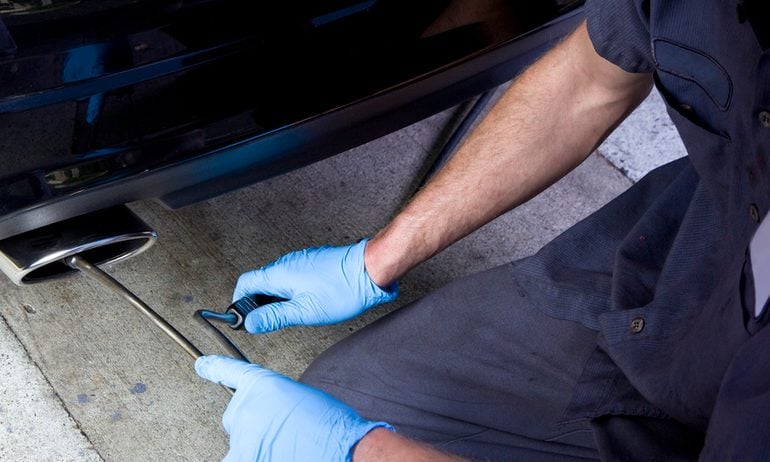Smog Tests: What They Are and How to Get Ready for One
If you live in a place that requires emissions tests, here’s what to expect.

Many, or all, of the products featured on this page are from our advertising partners who compensate us when you take certain actions on our website or click to take an action on their website. However, this does not influence our evaluations. Our opinions are our own. Here is a list of our partners and here's how we make money.
The U.S. Environmental Protection Agency has been regulating emissions since it was established in the 1970s. Among other things, it requires some states to test vehicle emissions. These tests are sometimes called smog checks.
Know your state’s rules
Not all states test emissions. And, for those states that do, the details can vary. Here are some things to look out for:
New vehicles might be exempt from testing for a few years.
Cars that are a few decades old are sometimes exempt from testing.
Some states only require testing if you live or work in a designated metropolitan area.
Some cars might not need testing every year.
You might be exempt from testing if you’re living in a state for college.
Some states require testing if you’re registering it for the first time after moving from another state.

See what you could save on car insurance
Easily compare personalized rates to see how much switching car insurance could save you.Be proactive about scheduling
As soon as you get a registration renewal notice calling for a smog check, mark your calendar and begin preparing.
“That way, if something goes wrong, you have plenty of time to address your issues,” says Dave Skaien, manager of the Automobile Club of Southern California’s approved auto repair program. Skaien also recommends paying registration fees early to avoid any late charges, although you won’t get your new registration until the smog test is complete.
Most states require emissions tests every two years, or before selling a car, but costs, requirements and testing methods vary. For example, some stations use a dynamometer test, particularly for older cars, which allows the wheels to turn and simulate driving conditions. So check your notice to see whether you need to bring your vehicle to a specific type of station.
Perform necessary maintenance
Your car owner’s manual outlines required maintenance at different mileage intervals. Tackle any necessary service items before having your car tested.
But don’t just wait for a smog test to do routine maintenance, Skaien says. Regularly perform oil changes and tuneups and be sure your tires are properly inflated. Then, when a smog test is required, you’ll be ready.
You can also try using a fuel injector cleaner, which can help clean carbon deposits from your engine and reduce emissions.

See what you could save on car insurance
Easily compare personalized rates to see how much switching car insurance could save you.Clear your check engine light
If your check engine light is on, you have a problem you need to address immediately, says David Rich, technical director for CarMD, an automotive repair information site.
Problems that trigger the check engine light could require inexpensive fixes, like a loose or damaged gas cap, or you might have to spring for more serious repairs. Find out and fix what’s causing your check engine light to illuminate.
But even after repairs that clear the check engine light, you need to drive until the car’s computer verifies that all operating systems are working correctly. That’s why the next step is so helpful.
Precheck your car
AutoZone stores, for example, offer a free diagnostic analysis you can use to pretest your car for smog-check readiness, Rich says. These tests aren’t just for smog tests, but they’ll alert you to any remaining issues. This is especially helpful if you’ve just had repairs performed or if you have an older car you’re worried might fail.
Tips for test day
Warm up your car. About 15 to 20 minutes of “reasonably enthusiastic driving” will bring your catalytic converter, which burns emissions, up to operating temperature, Rich says.
Remove any junk in the trunk. Extra weight makes it harder for your car to pass, Skaien says. So take your golf clubs and bowling balls out of your trunk.
Avoid rainy days. Wet tires can slip on a dynamometer test and cause your car to fail.
What to do if you fail your smog test
Knowing how to fix a car that’s failed a smog test is harder. The smog technician usually provides a form showing the reason your car failed and its emissions levels. Bring this to your mechanic to find out if they know how to fix the problem.
If you still have trouble locating the issue, ask your mechanic to perform a “smoke test” which forces smoke into the car’s evaporative system to find any leaks in the rubber hoses leading to and from the engine.
For cars that fail the first time, Skaien recommends retesting it at a “fix and repair” station rather than one that does testing only. Technicians there are experts in emissions systems repairs, minimizing the need for all of the driving back and forth between garages and testing stations that I experienced.
And finally, if you fail the test and you’re low on repair money, you might be eligible for financial assistance. For example, in California, the Consumer Assistance Program offers up to $1,200 to qualifying car owners for emissions-related repairs.


